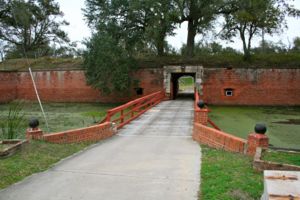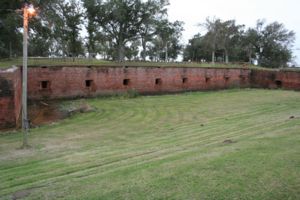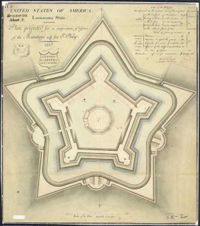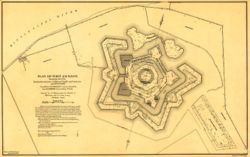Fort Jackson (2): Difference between revisions
John Stanton (talk | contribs) No edit summary |
John Stanton (talk | contribs) m Text replace - "<seo metadescription="Historic US and Canadian fortifications" />" to "<seo metadescription="Historic US and Canadian fortifications" /> {| style="margin: 1em auto 1em auto" width="800px" |- |" |
||
| Line 1: | Line 1: | ||
{{SocialNetworks}} | {{SocialNetworks}} | ||
{{PageHeader}} | |||
'''{{PAGENAME}}''' (1832-1922) - A [[Third System]] Coastal Fort first established in 1832 on the Mississippi River at Plaguemines Bend, Plaquemines Parish, Louisiana. Named after Gen. [[Andrew Jackson]], seventh President of the United States. Abandoned in 1922. | '''{{PAGENAME}}''' (1832-1922) - A [[Third System]] Coastal Fort first established in 1832 on the Mississippi River at Plaguemines Bend, Plaquemines Parish, Louisiana. Named after Gen. [[Andrew Jackson]], seventh President of the United States. Abandoned in 1922. | ||
{{Clr}} | {{Clr}} | ||
Revision as of 16:07, 20 February 2015
|
Fort Jackson (2) (1832-1922) - A Third System Coastal Fort first established in 1832 on the Mississippi River at Plaguemines Bend, Plaquemines Parish, Louisiana. Named after Gen. Andrew Jackson, seventh President of the United States. Abandoned in 1922.
 
Third System (1816-1867)Part of the Harbor Defense of the Mississippi. Defended Plaguemines Bend on the Mississippi River.
 Construction of the Third System fort began in 1822 and was completed in 1832 at a cost of $ 554,500. The fort was built on a foundation of three layers of cypress logs topped by cypress 2x4s submerged underwater. The fort walls are of red brick, twenty five feet high, twenty feet thick, with granite reinforced gun foundations. The fort layout is in the shape of a regular pentagon with arrow shaped bastions on each point. In the center was a 10 sided open center citadel that would reportedly house 500 troops. By the U.S. Civil War a separate water battery had been built on the right flank of the fort.
U.S. Civil War (1861-1865) On 8 Jan 1861, just before the start of the U.S. Civil War, Fort Jackson and Fort St. Philip were seized from their Federal garrisons by Louisiana forces. Louisiana troops occupied both Fort St. Philip and Fort Jackson until an epic battle with Union Admiral David Farragut's fleet of gunboats in April 1862 at Plaquemines Bend. Farragut's mission was to seize control of the Mississippi and split the Confederacy in two. In April 1862 Farragut's fleet engaged both forts and attempted to destroy them with a six-day bombardment. The bombardment failed to destroy the forts and Farragut was forced to make a run past both forts with 17 wooden ships at 2 AM on 24 Apr 1862. In the ensuing Battle of Forts Jackson and St. Philip, 13 of the ships made it past the forts, and Farragut went on to New Orleans which surrendered to him on 29 Apr 1862. Both forts gave a good account of themselves and in the end it was probably the lack of enough cannon that enabled the fleet to get by. Fort Jackson was designed for 93 gun emplacements but had only 69 guns emplaced while Fort St. Philip had only 45 guns. The Union gunboats were able to send a total of 8,100 rounds against both forts. Both forts were surrendered to Union forces on 28 Apr 1862 and then garrisoned by them until the end of the war. Endicott Period (1890-1910)Construction began on the first of two Endicott Period gun batteries in 1898 and both of them were constructed within the boundaries of the old fort. Battery Ransom was built right onto the parade and Battery Millar was built on top of the earthworks on the left flank. Both batteries were completed by 1901. Fort Jackson was operated as a subpost of Fort St. Philip and had only quarters for caretakers and no support buildings.

World War I (1917-1918)Fort Jackson was used as a training base during World War I. Use of Fort St. Philip and Fort Jackson (2) for coast defense purposes was discontinued 11 Mar 1920 as a part of the postwar disarmament program. The remaining gun batteries were disarmed and the guns shipped out over the next year and by 1922 both posts were abandoned. Fort Jackson was declared surplus in 1927 and was purchased by a New Orleans couple, they donated it to Plaquemines Parish in 1962 and it is still owned by the Parish. In 1960 Fort Jackson (2) and Fort St. Philip were designated National Historic Landmarks. Current StatusThe old fort is still closed to the public after being damaged by Hurricane Katrina and Rita. No period guns or carriages in place.
Sources:
Links: Visited: 9 Dec 2009 Fort Jackson (2) Picture Gallery
|
|||||||||||||||||||||||||||||||












